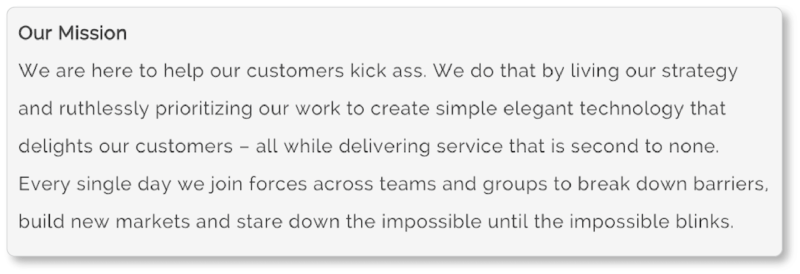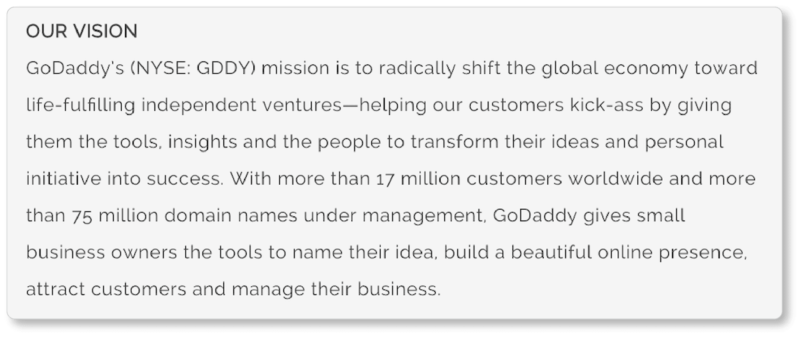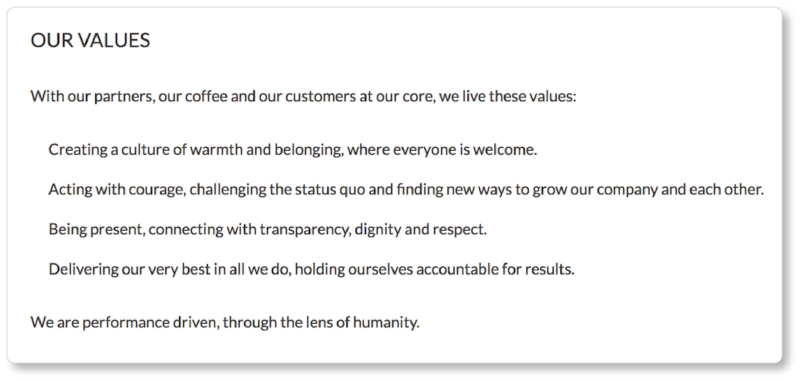- HOME
- Marketing
- Developing a Powerful Brand Positioning Strategy
- Defining Your Company's Mission, Vision, and Core Values
Defining Your Company's Mission, Vision, and Core Values
- 10 Mins Read
- Posted on December 4, 2018
- Last Updated on October 8, 2024
- By Lauren
Trying to position your brand without knowing your company’s mission, vision, and core values is like shoving a puzzle piece into a puzzle without bothering to take a look at its shape first. (Yeah; we’re playing on the word “position” there.) Intelligently positioning your brand means determining your company’s “contours”: the thing you decide to stand for—and the values you decide to abide by—for the long-term. Once you’ve carefully considered those contours, you’ll be better able to see where you fit into the landscape of your industry’s jigsaw—rather than attempting to force your piece of the puzzle into a series of positions that simply don’t fit.
Dee Hock, the founder and former CEO of Visa, once said: “I believe that purpose and principle, clearly understood and articulated, and commonly shared, are the genetic code of any healthy organization. To the degree that you hold purpose and principles in common among you, you can dispense with command and control. People will know how to behave in accordance with them, and they’ll do it in thousands of unimaginable, creative ways. The organization will become a vital, living set of beliefs.”
That shared purpose and “vital, living set of beliefs” are precisely what mission, vision, and values statements concern. If you’ve been in business for any amount of time, you know how easy it is to get caught up in the day-to-day routines of basic existence. Together, these three statements serve as a motivating force when routines begin to feel monotonous and lifeless, and as an anchor in times of upheaval and chaos. They’re where you’ll turn to remember your purpose, and to guide decisions at crisis points or crossroads. They’ll be your integrity check—through changing market forces, turnover, shifts in productivity, and so on.
Let’s begin with the differences between these three statements.
The Company Mission Statement
The mission statement answers four fundamental questions: What does your company do today, how does it do it, whom does it do it for, and how does it benefit that group? Notice we said today: A mission is grounded in the short term (3-5 years). In the words of marketing professor Neil Kokemuller, a mission statement “offers insight into what company leaders view as the primary purpose for being in business.” We like Kokemuller’s use of the words “insight” and “primary”; they’re good reminders that the role of a company mission is not to say everything. We’d only add that the best mission statements are viewed by the whole team—not just company leaders—as “the primary purpose for being in business.”
There’s a practicality and a present tense to the business mission statement: It describes the driving force behind your day-to-day operations, the practical things you’re doing to achieve your vision statement (more on that in a moment).
Keep in mind that the “who” doesn’t have to be limited to your customers. It can also speak to how you serve your employees, shareholders, community, or world. What needs or opportunities does your business address for any of these groups? How do you address them? What unique value do you provide in doing so?
The Company Vision Statement
While the mission statement answers the questions what, for whom, and how, the vision statement answers the questions why (what do we ultimately hope to achieve?) and where (where do we ultimately hope to be?). As you can tell by the word “ultimately,” vision statements are future-looking and aspirational: They articulate longer-term dreams. While your mission statement should be grounded in the reality of the present, your vision statement can be lofty. It outlines a worldview rather than describing your day-to-day. And it’s not always (or only) about the future of the organization, but about the future of the industry, society, or world in which the business hopes to effect change.
Hopefully you see where the relationship between the two lies: Your vision statement describes the world you ultimately want to see and help create, while your mission statement describes how you’ll go about achieving that vision. Or rather: Your vision statement is a description of the world that will eventually be if your organization can fulfill its mission statement—day, after day, after day.
At this point, it might be useful to see some examples of the two. Here are the vision and mission statements from The Alzheimer’s Association:

Notice how verb-heavy the organization’s mission statement is in comparison to their vision statement? The verbs answer the question “What is the purpose of the organization?” (To eliminate Alzheimer’s, provide care and support, and reduce the risk of dementia.) The mission statement also describes their who (“all affected” by the disease) and their how (“advancement of research,” “promotion of brain health”). Their vision statement, on the other hand, is lofty, aspirational, even somewhat utopian. But if the Alzheimer’s Association succeeds in their mission, that vision will come to fruition.
Here are GoDaddy’s mission and vision statements:
 GoDaddy’s mission focuses on two business aspects: its products (“creating simple elegant technology”) and its customer service. The company is working “ruthlessly” in its day-to-day activities to fulfill both claims, so that its customers can—today—”kick ass.” Their vision, on the other hand, imagines what the world could look like when all “independent ventures” are “kicking ass”: a global economy fueled by life-fulfilling activities. (Sounds great to us.)
GoDaddy’s mission focuses on two business aspects: its products (“creating simple elegant technology”) and its customer service. The company is working “ruthlessly” in its day-to-day activities to fulfill both claims, so that its customers can—today—”kick ass.” Their vision, on the other hand, imagines what the world could look like when all “independent ventures” are “kicking ass”: a global economy fueled by life-fulfilling activities. (Sounds great to us.)
The Company Values Statement
Core values are a kind of “code of ethics” for a business: They represent the fundamental beliefs that all employees should embody and stand behind, as well as the conduct expected of your team. Combined, your list of core values (we’d suggest 5 as an upper limit) defines the indispensable attributes of your company culture. You can think of them as some combination of character traits and convictions.
What beliefs are unique to your organization? In your day-to-day operations, what values guide your decision-making? What conduct do you expect your employees to uphold no matter what? What are the principles that primarily dictate how you run your business, treat each other, and treat your customers? These are some of the questions you’ll ask to get to your core values.
Examples of core values include sustainability, transparency, integrity, dependability, and efficiency. Of course, not listing something doesn’t mean you don’t value that thing! It just means you’ve chosen to emphasize other values. There will be times, after all, when you can’t be all things: Honest but not expedient, “green” but not economical. You’ll choose the things you hope to always be, regardless of circumstances.
Core values are typically presented either in list form or as a single value statement. Here are three different examples, from Starbucks, Adobe, and L. L. Bean:



Questions to Ask while Drafting Your Mission, Vision, and Values Statements
No matter whom you invite into the room to create these statements with, each statement will entail a different set of questions to get participants’ wheels turning. We offered a few above, but here are some others worth considering:
Questions for your mission statement:
- What do we do/create, and for whom? Exactly whose lives do we enrich, and how do we do so?
- Why did we choose this industry? And why did we choose to run our business this way rather than any other way?
- Why does what we do matter to us, and why does it matter to those we’re in business for?
- What’s the specific role our business plays in our industry?
- Why did we go into business to begin with? What did/do we most want for our customers/industry/community? Why do we keep showing up today?
- What’s the value we bring to our industry/our customers? What’s the difference it makes?
- What are our company’s short-term plans or goals?
Questions for your vision statement:
- Why does the problem our business seeks to solve ultimately need to be addressed?
- What are the measurable changes we believe our business can ultimately make?
- Where do we see our business/our customers/our community 20 years from now? 50? 100? What would a newspaper headline about our business look like at that point?
- If our organization’s goals were wholly achieved one day, what would our business/the community/the world look like?
- What would the world have to look like for our organization to be able to shut its doors and go out of business?
Questions for your core values:
- What behaviors are important enough to us that we’d let employees go who couldn’t uphold them?
- What values are important enough to us that we’d embody them regardless of whether they were rewarded? Regardless of whether they became a competitive disadvantage?
- What behaviors and values are important enough to us that we strive to embody them both on and off the job? The ones that, if we suddenly had enough money that we never had to work again, we’d still hold onto?
Let these questions lead you. Maybe you’ll focus on each statement one at a time; maybe you’ll have participants think about them all at once. Maybe you’ll bring in supporting documents: If you’ve done a company SWOT, for instance, the things you’ve listed under “opportunities” might help participants with their vision statements. You’ll edit ruthlessly when it’s time; in these initial stages, give yourself permission to write down anything and everything that comes to mind… and to have a little fun in the process.
Characteristics of Effective Mission, Vision, and Values Statements
Missions, visions, and core values come in a range of flavors; so while you may be tempted by templates, we’d urge you to reconsider. These statements should be reflective of your company’s personality, tone, and style, not read like a business-oriented mad lib. (Remember GoDaddy, whose mission is to help their customers “kick ass.”) That said, there are certain characteristics that make for strong statements. When it’s time to start editing, make sure your statements have these qualities:
- Brevity and precision. Your mission, vision, and values should be short enough to memorize. (Aim for 2 sentences max for your mission and vision statements, and 5 core values.) This means clarifying your organization’s objectives with utmost precision and abandoning every word that doesn’t add value. Ditch the complex language, industry buzzwords, technical jargon, and metaphors. And ditch the ambiguity. “Making the world better” means next to nothing. What does “better” mean, and exactly how is your business making it so?
- Singularity. Ask yourself whether your competitors could say the same things about their businesses. Do your statements collectively describe a unique experience and outcome that only you can provide? If you gave your statements to a customer alongside the statements from three other companies, would that customer be able to tell you which were yours? Does your vision statement describe an outcome that’s never occurred before in your industry?
- Achievability. Your target market has to believe you’re not giving them a bunch of fluff—whether through hyperbolic statements (“world-class”) or statements that promise more than what your company is capable of. Granted, vision statements can be the site for ambitious dreaming; but your mission statement and core values can’t be visionary. Don’t try to make your business something it’s not. Just because you’re not curing Alzheimer’s doesn’t mean you’re not doing good in the world. Offering terrific bike repair, trustworthy moving services, or local organic food is no small thing. Embrace what you do.
Pro tip: One way to ensure your statements are achievable is to determine key performance indicators (KPIs) so you can know when you’ve accomplished the goals set out by your mission and values statements.
- Inclusivity. By “inclusivity” we mean two things. Firstly, everyone in your organization needs to feel a sense of ownership around your statements. Remember: They’re your whole team’s purpose and vision; not just the CEO’s. Secondly, don’t make these statements limiting. Take Nike. Their mission is “to bring inspiration and innovation to every athlete in the world.” There’s nothing in there about sneakers—which means Nike has been able to expand their product offering to include apps and other technologies while remaining true to their mission. Ensure your statements are inclusive of all the ways your company might expand and grow.
Implementing and Revising Your Statements
Once you’ve got your statements, put them wherever you, your employees, and your customers can see them. Post them on your website; print them in your company handbook, brochures, and on business cards; add them to your letterhead; put them on your company swag; make them the theme of your ad campaigns; include them on your offer letters and the packing slips that accompany your shipped products; and so on. The point is that they stay vital and alive by being part of the daily conversation you and your employees are having with your customers. This will ensure both employees and senior leadership embody these ideas on a daily basis, and that employees automatically refer to them whenever it’s time to make a decision.
Nurturing your mission, vision, and values might also mean making them a part of the culture in more explicit ways. For instance, if your mission involves environmental sustainability, perhaps your team meets once a month to clean up your local beach, or employees are awarded for volunteering with local nonprofits with environmental missions. If your company vision involves a world of healthy citizens, perhaps you give your employees monthly allowances to be used specifically on fitness classes in town. If compassion is one of your core values, prioritize it in your performance reviews, or host brown bag lunches to discuss what compassion looks like in the workplace.
That said, give your statements room to change—and not because you couldn’t follow through on them, but because you grew out of them. Check in at least once a year and evaluate: Do your mission, vision, and values statements still speak to the heart of your company? Has your vision been achieved and do you need to give yourself a new target? Do you need to revise your mission to incorporate a new market segment, new products, or new technologies?
Better to sit down and revise than continue to uphold a mission or vision that no longer represents your company. When it is time for change, consider a press release to promote the new statement/s. Send out a letter to existing customers and clients explaining the reason for the change. You’ll get transparency points in their books for doing so.
Your mission, vision, and core values will give you a deep sense of clarity about many aspects of your business—and they’ll do the same for your customers. But these statements are just three of many that will describe the position you hope to occupy for your target market. In the next section, we discuss two others: your value proposition and unique selling proposition (USP).